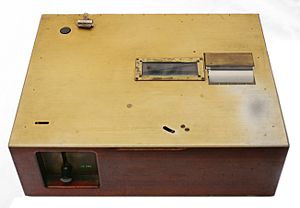Teaching machine facts for kids
Teaching machines were special devices. They helped students learn new things. These machines were mechanical. They showed information and checked if students understood it.

Contents
Inventing Teaching Machines
The first teaching machines were created by Sidney L. Pressey. His early machine asked students multiple-choice questions. If a student answered correctly, the machine would move on. Tests showed that students learned well this way. Later, Norman Crowder improved Pressey's ideas.
Skinner's Approach to Learning
Another important person was B.F. Skinner. He made a different kind of teaching machine. Skinner's machine used his ideas about positive reinforcement. This means the machine would guide learning by giving positive feedback. It helped students learn step-by-step.
How Teaching Machines Helped Learning
Both types of teaching machines worked very well. They helped students learn many different subjects. This way of learning is called programmed learning. It also worked well in other forms, like special books.
The ideas from teaching machines were very important. They led to new ways of learning later on. These include open learning and computer-assisted instruction. These modern methods still use some of the same ideas.
See also
In Spanish: Máquina de enseñanza para niños

